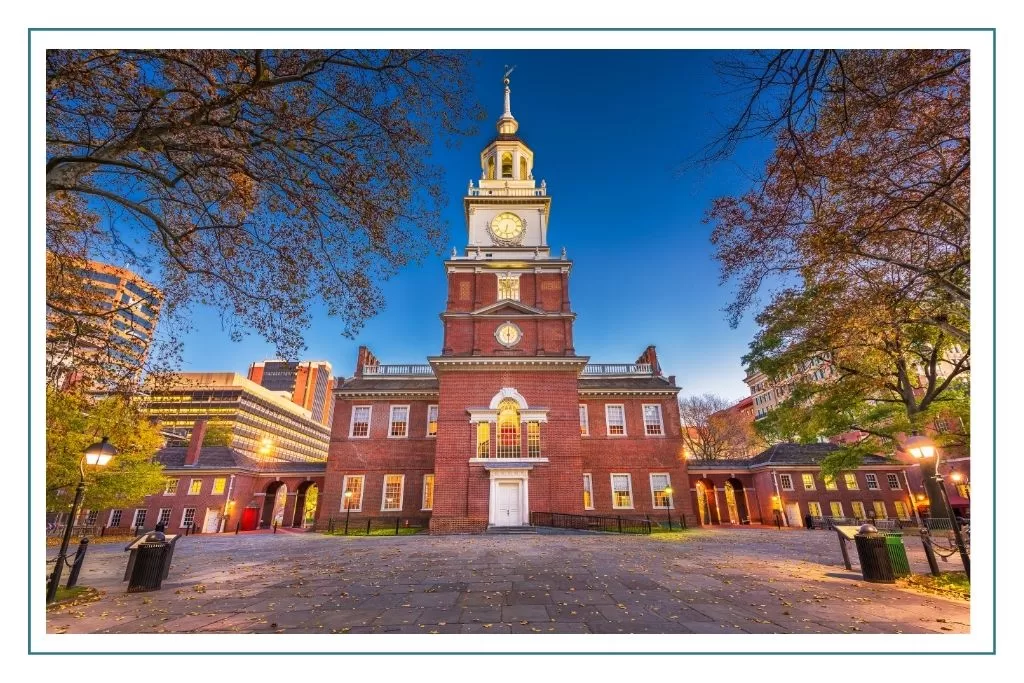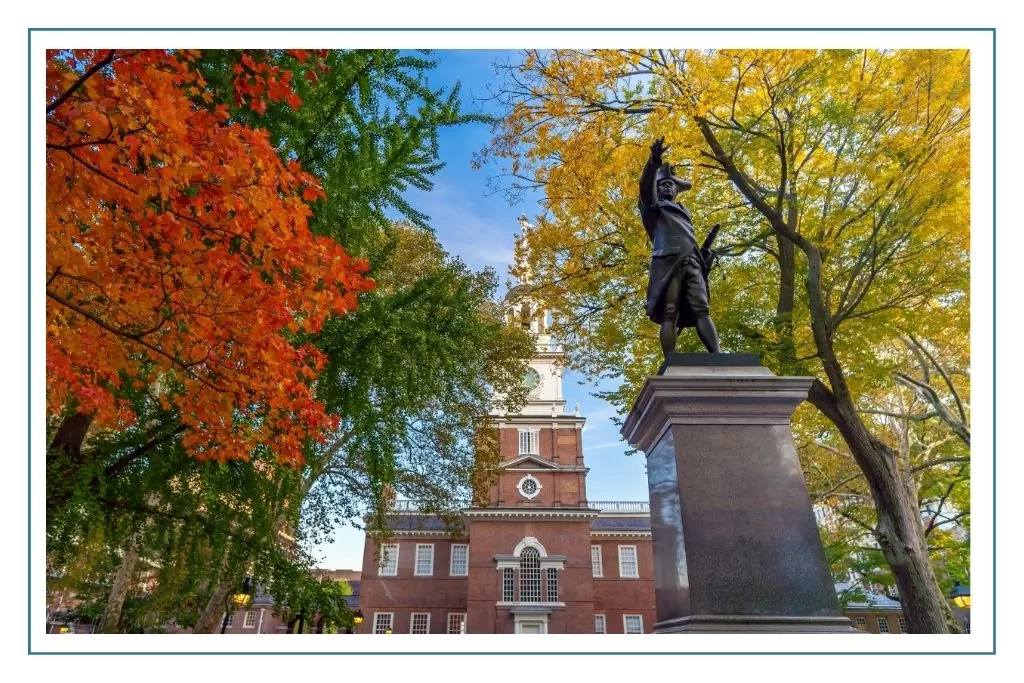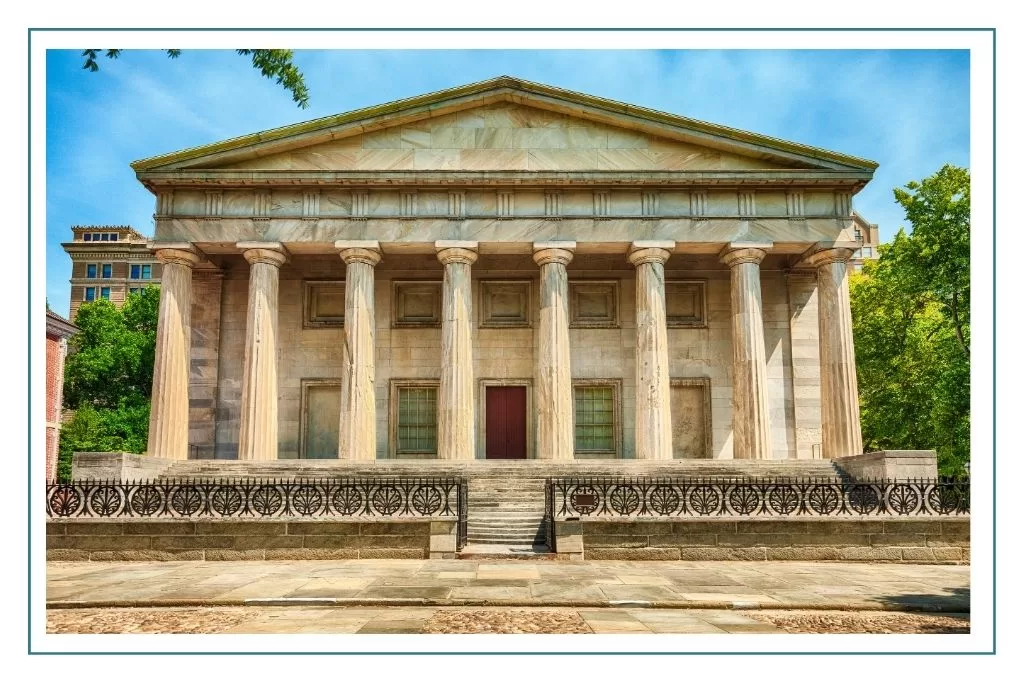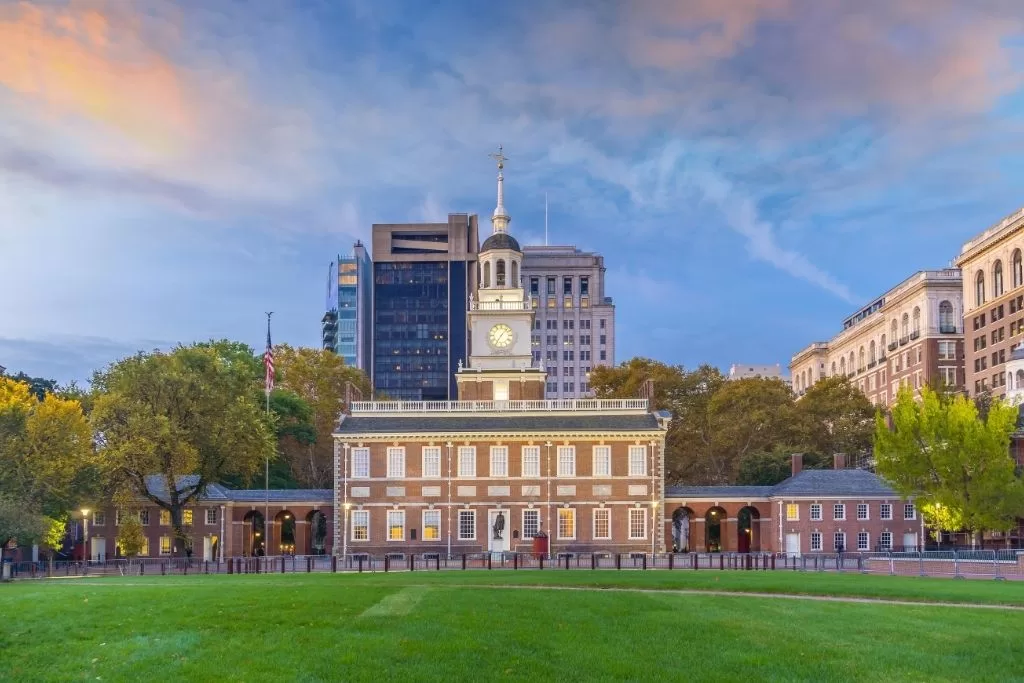Philadelphia’s Revolutionary Past: A Self-Guided Walking Tour
My family and I recently had the opportunity to spend an afternoon in downtown Philadelphia, Pennsylvania. Philadelphia is steeped in history. Revolutionary figures such as George Washington, Benjamin Franklin, Thomas Jefferson, and Alexander Hamilton met in the halls and taverns of the city to debate and plan for freedom from the rule of King George III. The Continental Congress met in Philadelphia, and, with the adoption of the Declaration of Independence, formally proclaimed sovereignty from Britain on July 4, 1776. Several years later in 1787, the U.S. Consitution was also signed inside Independence Hall.
Today, these historic buildings, which were once situated in the rural countryside, stand in contrast to the busyness of the city and the modern-day high rises that have grown around them. This walkable, self-guided tour of notable Revolutionary sites in Philadelphia begins at Independence Square. To walk this route takes approximately 45 minutes to an hour, but I recommend allowing additional time to explore these sites in more detail, as many of them offer admission. There are also several museums nearby that are worth a visit, including the Independence Visitor’s Center, the National Constitution Center, the Benjamin Franklin Museum, and the Museum of the American Revolution.
- 1. Independence Square
- 2. Independence Hall and Statue of George Washington
- 3. The Liberty Bell Center
- 4. The President's House Site
- 5. Benjamin Franklin Burial Site
- 6. Betsy Ross House
- 7. Elfreth's Alley
- 8. Christ Church
- 9. B Free Franklin Post Office
- 10. Fragments of Franklin Court
- 11. First Bank of the United States
- 12. Carpenter's Hall
- 13. Second Bank of the United States

1. Independence Square
- Independence Square is the courtyard directly to the south of Independence Hall. Independence Hall stands at the center and is flanked by the West Wing and Congress Hall on the west, and Philosophical Hall, which currently houses the Museum of the American Philosophical Society, on the east.
- The West Wing contains a small exhibit of original printed 18th-century documents, as well as a silver inkstand believed to be the one used by the signers of the Declaration of Independence.
- Congress Hall is where the United States Congress met from 1790-1800, while Philadelphia was the capital city of the United States.
- Benjamin Franklin founded the Museum of the American Philosophical Society, which contains books, photographs, and other rare artifacts from the era.
- A statue of American Revolutionary Naval Officer, John Barry, stands in the center of the courtyard.
- It was in Independence Square that the Declaration of Independence was first read out loud to the public on July 8, 1776.


Address: Independence Hall is located at 520 Chestnut Street. Independence Square is located on the south side of the building.
Hours: The West Wing and Congress Hall are open daily from 9:00 AM – 5:00 PM. The Museum of the American Philosophical Society is open April through December from 10:00 AM – 5:00 PM, Thursdays through Sundays only.
Things to Know: Admission to the West Wing is free on a first-come, first-served basis. Admission to Congress Hall is free, but is by presentation only, which runs every 20 minutes. Admission to the Museum of the American Philosophical Society is free, but a small donation of $2 to $5 is encouraged. Visitors must pass through a security screening to gain access to these exhibits.
2. Independence Hall and Statue of George Washington
- Once known as the Pennsylvania State House, Independence Hall was the site of both the signing of the Declaration of Independence in 1776, and the U.S. Constitution in 1787.
- Construction on Independence Hall began in 1732, culminating in 1753 with the addition of the bell tower.
- Originally conceived as the Pennsylvania State House, it served as the seat of government for the colony. In 1775, the Second Continental Congress convened at Independence Hall, setting the wheels in motion for the Declaration of Independence. Just over a decade later, in 1787, history was made again as the Constitutional Convention assembled here to draft the framework of the American government – the U.S. Constitution.
- Independence Hall has undergone several reconstructions and restorations throughout the centuries, with the interior being restored to its original appearance in 1948. Today, it stands not only as a landmark but as a powerful symbol of American democracy. Its image even graces the back of the U.S. $100 bill, a testament to its enduring legacy.
- A statue of George Washington stands in front of Independence Hall on Chestnut Street. The original marble rendition, dedicated in 1869, has since been replaced by the current bronze replica, which was unveiled in 1910.


Address: Independence Hall is located at 520 Chestnut Street.
Hours: Independence Hall is open from 9:00 AM – 5:00 PM daily.
Things to Know: Admission to Independence Hall is $1.00. Timed tickets are available for purchase through Recreation.gov. Visitors must pass through a security screening to gain access to the center.
3. The Liberty Bell Center
- Originally known as the State House Bell, the Liberty Bell was installed in the tower of Independence Hall in 1753. Its primary purpose was to call lawmakers to meetings within the Pennsylvania State House.
- Tradition holds that the Liberty Bell’s toll echoed triumphantly through Philadelphia on July 8, 1776, as the Declaration of Independence was read aloud for the first time to the public in nearby Independence Square.
- Weighing in at nearly a ton, the Liberty Bell was cast in London in 1752. It arrived in Philadelphia only to crack upon its first ring. It was subsequently melted down and recast, not once, but twice, by two local founders.
- In 1777, the bell was removed from the tower and hidden to protect it during attacks on the city by British troops during the American Revolutionary War. After the war, the bell tower was starting to deteriorate, so the bell was placed into storage until the tower could be refurbished. The bell was reinstalled in 1785.
- The distinctive large crack that exists on the bell today did not occur until the mid-1800s, although the exact date and cause are unknown.


Address: The Liberty Bell Center is located at 526 Market Street.
Hours: The Liberty Bell Center is open daily from 9:00 AM – 5:00 PM.
Things to Know: Admission to the Liberty Bell Center is free. Visitors must pass through a security screening to gain access to the center. The Liberty Bell can be viewed outside normal business hours through windows facing Independence National Historical Park.
4. The President’s House Site
- The three-and-a-half-story brick house that once stood one block north of Independence Hall was built in approximately 1767.
- After the Revolutionary War ended, and while Philadelphia was the nation’s temporary capital, this home served as the Presidential Mansion. George Washington resided here from 1790 to 1797 while he served as America’s first president. When John Adams was elected to succeed Washington in 1797, he moved into the home and lived there until 1800, when he relocated to the present-day White House in Washington, D.C.
- Today, all that remains of the house is part of the foundation, which can be viewed through a glass enclosure in the exhibit.



Photo credit: Wikipedia.com
Address: The President’s House Site is located at the corner of 6th Street and Market Street.
Hours: The President’s House Site is open from 7:00 AM – 10:00 PM daily.
Things to Know: The President’s House Site is an outdoor exhibit. There is no admission fee.
5. Benjamin Franklin Burial Site
- Benjamin Franklin and several other notable historical figures are buried at Christ Church Burial Ground.
- When the churchyard cemetery became full in 1719, the church purchased 2 acres of land a few blocks away in order to expand.
- Christ Church Burial Ground is still an active cemetery today.
- Due to the phrase “A penny saved is a penny earned,” famously attributed to Benjamin Franklin, many visitors leave pennies on his gravesite.
- In 1858, railings were thoughtfully inserted into the brick fence surrounding the cemetery to allow a glimpse of the gravesite of Benjamin Franklin even after the cemetery has closed for the day.

Address: Christ Church Burial Grounds is located at 5th and Arch streets.
Hours: Christ Church Burial Ground is open daily from 11:00 AM – 5:00 PM. It is closed during January and February, and on Easter Sunday, Thanksgiving, and Christmas.
Things to Know: Admission to Christ Church Burial Grounds is $5 for adults, and $2 for children aged 5 to 12. A guided tour is available for an additional fee.
6. Betsy Ross House
- Betsy Ross is said to have moved into this home on Arch Street after the death of her husband in 1776. It is still debated as to whether or not this is the actual house where Betsy Ross lived and sewed the first American flag, as historical evidence suggests it may have been in a neighboring house that has since been demolished.
- Although there is no written history of these events, there is significant evidence to support the story of how George Washington entered Betsy Ross’ upholstery shop, located on the lower level of the house, and commissioned her to sew the first American flag.

Address: The Betsy Ross House is located at 239 Arch Street.
Hours: The Betsy Ross House is open March through November from 10:00 AM – 5:00 PM daily, and December through February from 10:00 AM – 4:30 PM, Wednesday through Monday.
Things to Know: Admission to the Betsy Ross House is $10 for adults and $8 for children ages 6 to 12, seniors age 65+, and students and military with a valid ID. An audio guide is available for an additional fee.
7. Elfreth’s Alley
- Step back in time on Elfreth’s Alley, a charming cobblestone street that holds the honor of being the nation’s oldest continuously inhabited street, dating back to 1703.
- Stroll past 32 meticulously preserved homes, most of which are privately owned, offering a glimpse into Philadelphia’s rich heritage.
- Delve deeper into its history at the Elfreth’s Alley Museum, where you’ll discover fascinating artifacts and stories that bring to life the artisans, tradespeople, and families who once called this alley home.


Address: Elfreth’s Alley Museum is located at 126 Elfreth’s Alley.
Hours: Elfreth’s Alley is open to pedestrians at all hours. Elfreth’s Alley Museum is open Friday, Saturday, and Sunday from 12:00 PM – 4:00 PM
Things to Know: Admission to Elfreth’s Alley Museum is $3 for adults and $2 for children ages 7 to 12. An audio tour is available at an additional fee and can be purchased using your smartphone through elfrethsalley.org/audiotour.
8. Christ Church
- Christ Church was founded in 1695 and originally housed in a modest wooden structure. As the congregation grew, the need for a larger church building became apparent.
- Construction of the current church began in 1727 and spanned over two decades, culminating in 1744. The crowning achievement arrived in 1754 with the addition of a magnificent steeple. Reaching 196 feet, Christ Church briefly held the title of the tallest building in North America.
- Christ Church holds the distinction as the birthplace of the American Episcopal Church. Among the church’s former members were iconic figures like George Washington, John Adams, Benjamin Franklin, and Betsy Ross. Bronze plaques throughout the sanctuary mark the pews where these historical figures once sat.
- Originally, burials took place in a small cemetery yard directly adjacent to Christ Church. However, as space grew limited, a new plot of land was purchased, leading to the establishment of the Christ Church Burial Grounds, located just a short distance away.


Address: Christ Church is located at 24 North 2nd Street.
Hours: Christ Church is open Monday through Saturday from 11:00 AM – 5:00 PM, and on Sundays from 9:45 AM – 11:00 AM and 11:30 AM – 5:00 PM.
Things to Know: Admission to Christ Church is $5 for adults and $2 for children aged 5 to 12. A guided tour is available for an additional fee. Services are held on Sundays at 10:00 AM and Wednesdays at 12:00 PM and are open to the public.
9. B Free Franklin Post Office
- During the Revolutionary War, it became increasingly important to develop an efficient and reliable system of communication between the colonies.
- Benjamin Franklin was experienced as a printer and publisher and was appointed as postmaster of Philadelphia in 1737. Later, in 1757, he became co-Postmaster General of the North American colonies, and eventually the Postmaster General under the Continental Congress.
- Franklin helped to refine the postal system in the colonies and overseas, creating a delivery schedule and increasing the speed at which information was relayed.
- The B. Free Franklin Post Office faithfully recreates Benjamin Franklin’s print shop, and even functions as a fully operational U.S. Post Office.
- Interestingly, you won’t find an American flag flying here as you would at all other U.S. Post Offices – a nod to the fact that the flag itself wasn’t created until after Franklin’s service as Postmaster General.

Address: The B. Free Franklin Post Office is located at 316 Market Street.
Hours: The B. Free Franklin Post Office is open Monday through Saturday 9:00 AM – 12:45 PM and 2:00 PM – 5:00 PM.
Things to Know: Mail a letter or postcard from the B. Free Franklin Post Office and your stamp will be hand-canceled using Postmaster Benjamin Franklin’s cancelation.
10. Fragments of Franklin Court
- Franklin Court is the site of the former residence of Benjamin Franklin. From 1763 until his death in 1790, this is the address where Franklin lived and worked. Visitors can enter the courtyard through the original, arched passageway that still stands on Market Street, just as it did in Franklin’s time. The site now features a museum dedicated to his life and legacy, along with a reconstructed 18th-century printing office.
- Unfortunately, the original house and shop were demolished in 1812 to make way for new development. Over the following century, various businesses opened over the spot where Franklin’s home once stood, its foundation buried beneath the bustling streets. Thankfully, archaeological digs began in the 1950s, leading to the exciting rediscovery of Franklin’s home’s foundation.
- Today, steel “ghost structures” stand where the house and printing office once did. Viewing portals allow passersby to see portions of the foundation walls, and even Benjamin Franklin’s privy pit!




Address: Entrances to the Franklin Court Courtyard can be found on both Market Street and Chestnut Street, between 3rd and 4th Streets.
Hours: Franklin Court Courtyard is open from 9:00 AM to 5:00 PM daily.
Things to Know: Also located in the courtyard is the Franklin Court Printing Office. This is a recreation of a 1700s printing office where visitors can watch demonstrations of old printing techniques. The printing office is open Thursday through Monday from 10:00 AM – 5:00 PM. There is no admission fee for the printing office.
11. First Bank of the United States
- Following the Revolutionary War, the newly created country was in debt and in need of an organized financial system. Alexander Hamilton introduced a plan to give the federal government authority over the nation’s finances with the creation of a national bank. His goals included paying off war debts and creating a common currency.
- The bank was initially housed a few steps away inside Carpenter’s Hall, but in 1797, it moved to a more permanent location – the columned structure on 3rd Street that stands today.
- By 1811, the bank faced mounting opposition. Critics argued that government control stifled private enterprise and profitability. This opposition proved successful, and Congress declined to renew the bank’s charter. Over the following decades, the building served various private banks until the National Park Service took ownership in 1955.

Address: The First Bank of the United States is located on 3rd Street, between Walnut and Chestnut Streets.
Hours: N/A
Things to Know: The First Bank of the United States has been closed to the public since the 1970s.
12. Carpenter’s Hall
- Built in 1770 – 1771, Carpenter’s Hall originally served as a meeting space for craftsmen and builders.
- In 1774, the building served as the location for the meetings of the First Continental Congress. Delegates from various colonies gathered here to discuss rising tensions with Great Britain, a pivotal step towards the American Revolution.
- During the war, Carpenter’s Hall housed hospitals for both British and American troops. It has also temporarily hosted The American Philosophical Society and the First and Second Banks of the United States, among other organizations through the years.
- Carpenter’s Hall was the site of America’s first bank robbery in 1798. Over $162,000 (equivalent to almost $3 million today) was stolen. The two perpetrators were caught and the money was returned.
- Today, the building is still owned by the Carpenter’s Guild, as it has been since its inception, and is a designated historic monument and museum.

Address: Carpenter’s Hall is located at 320 Chestnut Street.
Hours: Carpenter’s Hall is open 10:00 AM – 4:00 PM, Tuesday through Sunday.
Things to Know: Admission to Carpenter’s Hall is free. The building to the west of Carpenter’s Hall is New Hall, a military museum.
13. Second Bank of the United States
- Following the financial strain of the War of 1812, the United States faced a situation similar to the one that followed the Revolutionary War: a nation burdened by debt and a need for a stable financial system. To address this, the Second Bank of the United States was chartered in 1816
- The columned architecture was inspired by the Parthenon in Greece and was constructed between the years of 1819 and 1824. Inside the bank building is an exhibit featuring a collection of more than 150 original portraits of notable figures from U.S. history, most by artist Charles Willson Peale.
- Inspired by the architecture of the Parthenon in Greece, the bank was constructed between 1819 and 1824. Inside, visitors will discover a fascinating art collection featuring over 150 original portraits, most by artist Charles Willson Peale, depicting notable figures from American history.

Address: The Second Bank of the United States is located at 420 Chestnut Street.
Hours: The Second Bank of the United States is currently closed to the public. It is scheduled to reopen in the fall of 2024.
Options for Guided Tours
If you prefer a guided tour of some of the sites instead of venturing out on your own, below are some excellent options!
Sources:
NPS.gov, “Visiting the Liberty Bell Center”
NPS.gov, “Visiting the President’s House Site”
NPS.gov, “Visiting Independence Hall”
NPS.gov, “Visiting the Great Essentials Exhibit in The West Wing”
NPS.gov, “Visiting Congress Hall”
NPS.gov, “Visiting the Franklin Court Courtyard”
NPS.gov, “Christ Church Burial Ground”
NPS.gov, “B. Free Franklin Post Office”
NPS.gov, “Visiting the Franklin Court Printing Office”
NPS.gov, “Franklin Court Printing Office”
NPS.gov, “First Bank of the United States”
NPS.gov, “Second Bank of the United States”
NPS.gov, “Carpenter’s Hall”
American Philosophical Society, “Visit the Museum”
History.com, “Declaration of Independence”
History.com, “Continental Congress”
History.com, “Constitution”
History.com, “Franklin Court”
History.com, “B. Free Franklin Post Office”
History.com, “How Ben Franklin Established the U.S. Post Office”
History.com, “Bank of the United States”
CarpentersHall.org
Visit Philadelphia, “Christ Church Burial Ground”
Visit Philadelphia, “Elfreth’s Alley”
ChristChurchPhila.org
Historic Philadelphia, “Betsy Ross House”
USPS.com, “No Flag Flies Here”
FrauncesTavernMuseum.org, “Post Office”
CarpentersHall.org
